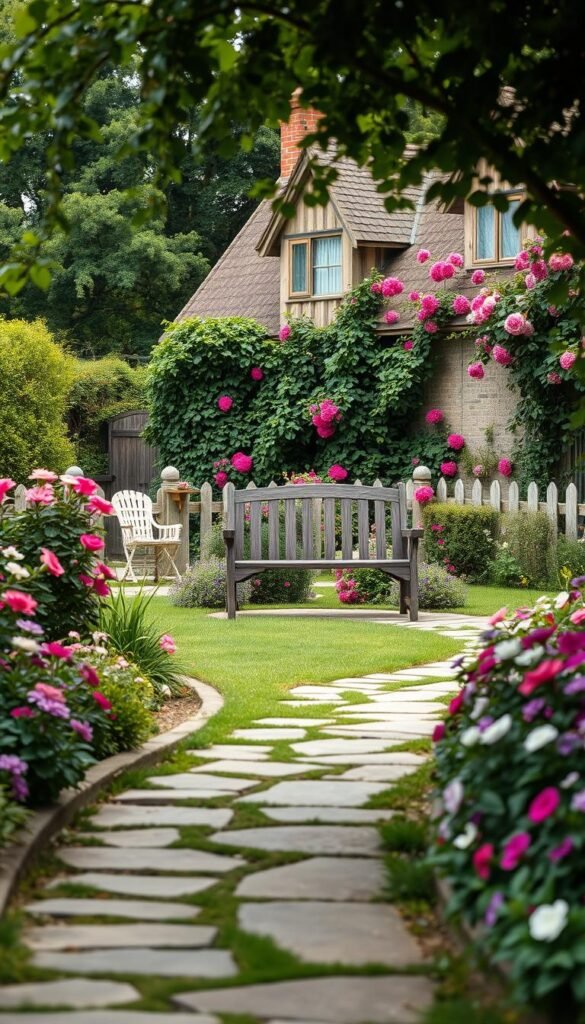Imagine stepping into a space where structured elegance meets wild, blooming beauty. This design approach blends crisp hedges with overflowing flower beds, creating a balance between order and nature’s spontaneity. Originally crafted for grand estates, its principles now adapt beautifully to modern yards of all sizes.
At its core, this aesthetic pairs geometric pathways and manicured lawns with soft, free-form plantings. Think of weathered stone accents guiding visitors through lush greenery, or climbing roses framing a vintage bench. The magic lies in contrasting clean lines with organic shapes—a concept that works even in compact areas.
You’ll learn how to mix timeless elements like walled spaces and water features with cottage-style elements for personalized charm. Discover strategic layering techniques that create depth without clutter, using plants that thrive in your local climate. Whether you’re starting fresh or refining existing layouts, these ideas help craft a retreat that feels both intentional and effortlessly inviting.
Designing Your English Garden Backyard Style: Romantic Borders and Cottage Focal Points
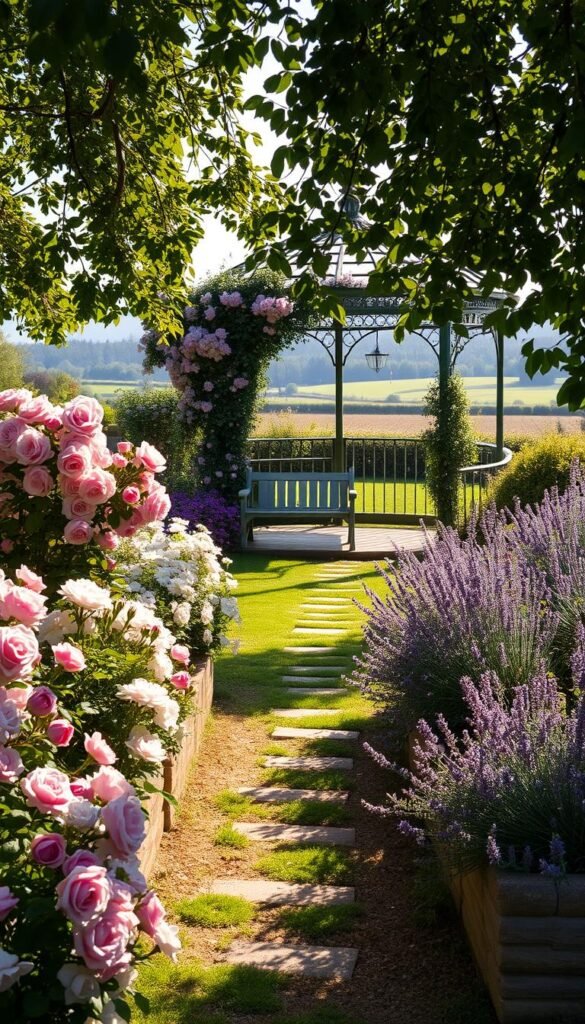
Your journey begins with sunlight and soil. Identify areas receiving 6-8 hours of daily sun during spring and summer – perfect for vibrant blooms. Test drainage by digging a 12-inch hole; if water remains after an hour, mix in compost or sand to improve flow.
Gather ideas from botanical spaces or online resources for elevating your outdoor. Sketch rough layouts using these three elements:
| Feature | Purpose | Material Examples |
|---|---|---|
| Pathways | Guide movement | Reclaimed brick, gravel |
| Planting zones | Create depth | Layered perennials |
| Decorative accents | Add personality | Vintage urns, birdbaths |
Balance sizes carefully. A large stone bench pairs well with delicate foxgloves. Small trellises work better near compact hydrangeas. Always match plant heights to their location – taller varieties belong at the back of beds.
Define spaces using low hedges or flowering shrubs. This creates separate “rooms” while maintaining airflow. Leave space between features for easy maintenance access without sacrificing the lush, full look.
Embracing Traditional English Garden Elements
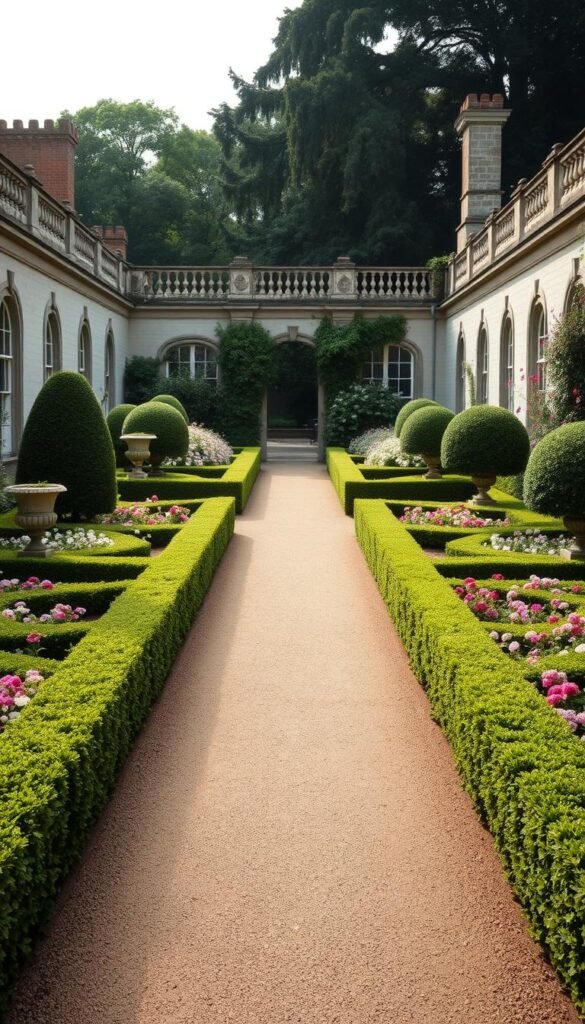
Establishing clear structure transforms your outdoor space into a living masterpiece. Through strategic planning, you’ll craft distinct areas that invite exploration while maintaining harmony. These timeless principles work equally well in urban plots and sprawling properties.
Incorporating Symmetry and Structure
Defined spaces form the skeleton of authentic design. Use low boxwood hedges to outline seating nooks or herb gardens. Pair these with symmetrical elements like matching topiaries flanking a weathered bench.
Create visual rhythm through repeating shapes. Try circular rose beds mirrored on either side of a gravel walkway. This approach maintains order while allowing floral displays to shine.
Utilizing Classic Hardscape Features
Stone pathways anchor your layout while guiding foot traffic naturally. Choose materials like aged brick or flagstone that develop character over time. Wrought iron gates make elegant transitions between garden rooms.
Consider these durable elements for lasting impact:
- Crushed limestone borders defining flower beds
- Moss-covered statuary as focal points
- Arched trellises dividing functional zones
These features provide year-round interest, ensuring your space remains engaging even in winter months. They create the perfect canvas for layering colorful blooms in warmer seasons.
Incorporating Romantic Borders in Your Landscape
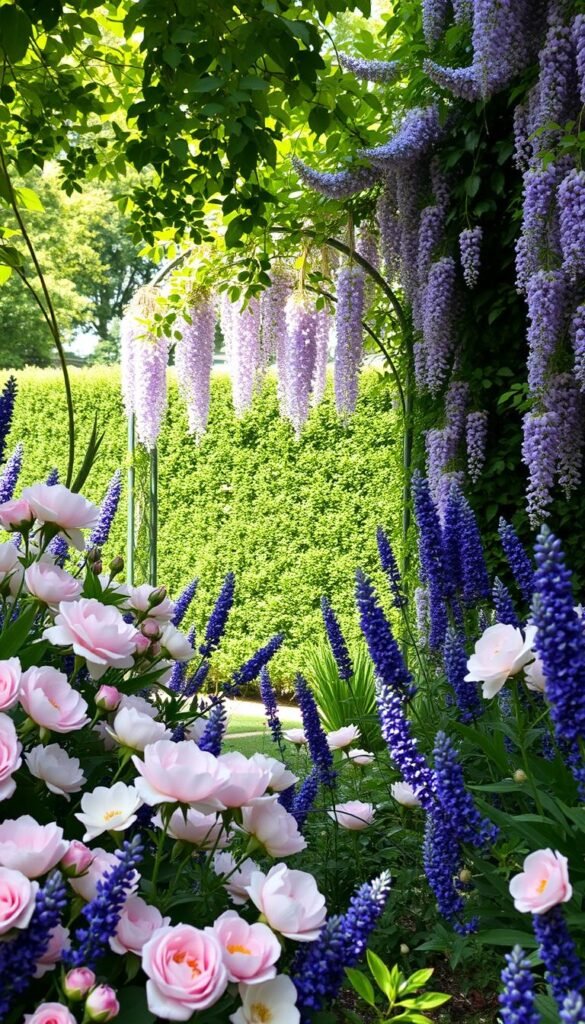
Crafting a sensory-rich outdoor space starts with thoughtfully designed planting areas. These lush edges combine color, texture, and fragrance to create living art that evolves through seasons.
Choosing Fragrant Flowers and Lush Foliage
Prioritize scent-heavy varieties that perfume the air. Roses and lavender form the backbone of traditional designs, while jasmine climbing trellises adds vertical interest. Peonies and phlox bring bursts of color from spring through fall.
Consider this bloom schedule for continuous fragrance:
| Season | Flower | Height |
|---|---|---|
| Spring | Lilac | 6-8 ft |
| Summer | Honeysuckle | 10-15 ft |
| Fall | Pinks | 8-12 in |
Creating Intimate Planting Beds
Pack plants tightly – leave just enough space for mature growth. This density creates natural mulch through overlapping leaves, reducing watering needs. Mix tall foxgloves with mid-height salvias and trailing thyme for textural contrast.
Position fragrant varieties near seating areas where their scents linger. A bench surrounded by lilies becomes a fragrant retreat, while lavender lining walkways releases aroma with every passing breeze.
Rotate seasonal annuals between perennial anchors to maintain color intensity. This approach keeps beds lively while preserving their structured wildness – the hallmark of timeless design.
Creating Cottage Focal Points with Character
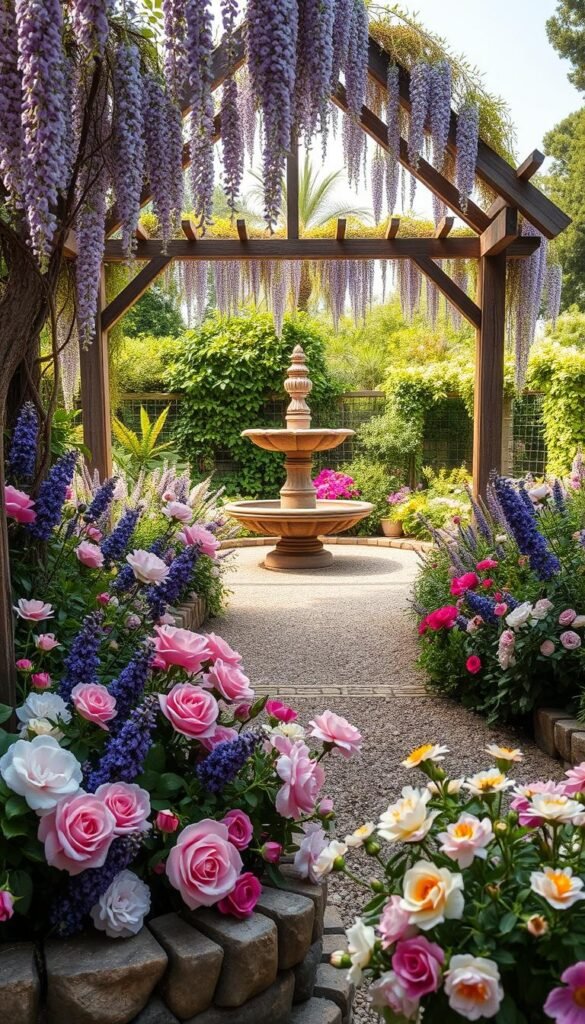
Every great garden tells a story through its details. Thoughtful accents become visual anchors that guide exploration while adding personality to your outdoor space. Let’s explore how to weave narrative charm into your layout.
Using Vintage Garden Accessories
Weathered urns and cracked planters gain new life when overflowing with trailing ivy or vibrant petunias. Hunt for stone statues featuring whimsical animals or classical figures – their aged patina blends seamlessly with lush greenery. A reflective gazing ball nestled among ferns creates unexpected light play.
Highlighting Unique Garden Sculptures
Position statement pieces where they’ll spark curiosity. Try these placement strategies:
- Stone birdbaths surrounded by low-growing thyme
- Rustic metal arches dripping with clematis
- Repurposed wooden barrels bursting with geraniums
Balance scale carefully – a small cherub statue pairs beautifully with delicate violas, while larger concrete urns command attention beside hydrangea bushes. Leave breathing room around each piece to let its character shine without visual competition.
Mix functional and decorative elements. An antique watering can becomes a planter, while vintage gates frame views of your blooming borders. These touches create layered interest that evolves as visitors meander through your garden rooms.
Planning and Zoning Your Garden Rooms
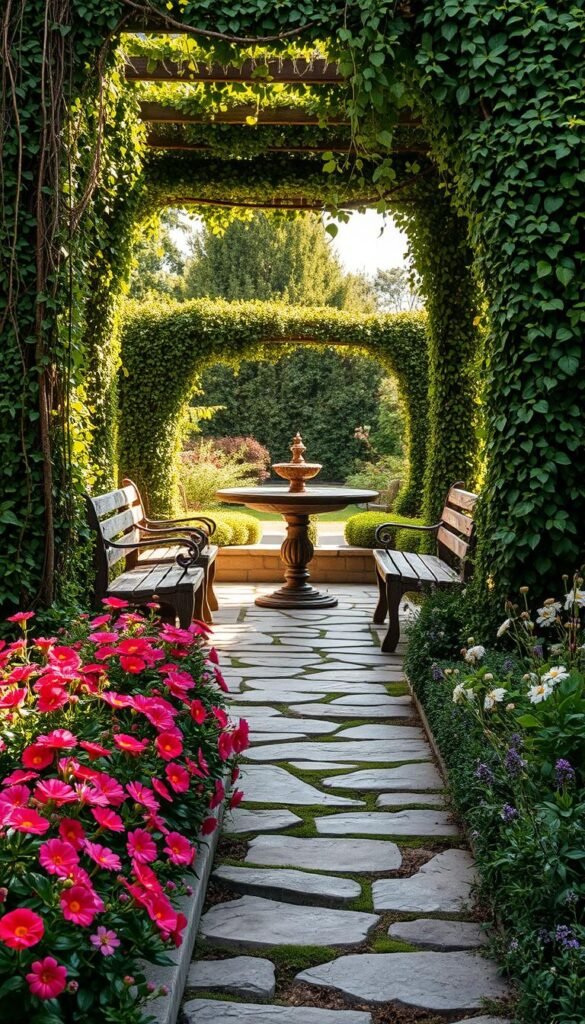
Transform your yard into a sequence of inviting destinations through smart spatial design. By dividing your landscape into purposeful zones, you create intrigue and maximize every square foot. This approach works wonders for both sprawling properties and cozy urban plots.
Defining Spaces with Hedges and Walls
Living walls serve multiple roles – they mark boundaries, reduce noise, and support climbing plants. Boxwood hedges create crisp edges for dining areas, while flowering quince shrubs add seasonal color to relaxation zones. Consider these enclosure options:
| Material | Height | Best For |
|---|---|---|
| Privet hedge | 4-6 ft | Privacy screens |
| Stone wall | 2-3 ft | Seating borders |
| Lattice panels | 6-8 ft | Vertical gardening |
Leave strategic gaps in walls for peek-a-boo views between spaces. A wrought iron gate between vegetable plots and play areas maintains separation while allowing supervision.
Establishing Functional Garden Corners
Carve out specialized zones that match your lifestyle. A sunny south-facing corner becomes the perfect herb station, while shaded northern spots host fern-filled reading retreats. Keep these tips in mind:
- Place fire pits 10+ feet from plantings
- Use permeable pavers in wet zones
- Install raised beds in cooking areas
Connect your zones with curved pathways that encourage leisurely exploration. Pro tip: Position fragrant plants near seating areas where their scent lingers longest. This thoughtful zoning creates a landscape that feels both expansive and intimately yours.
Selecting the Right Plants and Perennials
Your plant choices set the stage for a thriving landscape that balances beauty with practicality. Focus on varieties offering visual impact and easy care, blending classic charm with modern resilience.
Roses and Lavender: Timeless Partners
Disease-resistant roses form the backbone of lush plantings. Opt for climbing types like ‘New Dawn’ to adorn fences, while shrub varieties like Knock Out® add structure. Ground cover roses spill gracefully over edges, softening hardscapes.
| Rose Type | Best Use | Top Varieties |
|---|---|---|
| Climbing | Vertical accents | Zephirine Drouhin |
| Shrub | Hedging | Oso Easy® |
| Ground Cover | Slopes/Edges | Flower Carpet® |
Pair roses with lavender’s silvery foliage for contrast. The aromatic duo attracts pollinators while resisting deer. Underplant with catmint for continuous blooms from spring through frost.
Evergreen Anchors for Four-Season Interest
Boxwood hedges frame flower beds neatly, while holly adds berry-rich winter color. Conifers like columnar yews create living backdrops that highlight seasonal stars.
| Evergreen | Feature | Design Role |
|---|---|---|
| Boxwood | Shearable | Formal edges |
| Junipers | Drought-proof | Ground cover |
| Yew | Shade-tolerant | Privacy screens |
Mix 30% evergreens with flowering plants. This ratio maintains structure while allowing vibrant seasonal changes. Your space stays inviting even when roses rest between blooms.
Utilizing Hardscaping to Define Your Garden
The foundation of an inviting landscape lies beneath your feet. Thoughtful hardscaping weaves practicality with visual flow, guiding movement while framing nature’s artistry. Materials like weathered brick or irregular flagstone add timeless texture underfoot.
Designing Stone Pathways and Meandering Trails
Curved walkways spark curiosity better than straight lines. Use irregular stone pavers for organic charm, spacing them slightly to allow creeping thyme or moss between cracks. This softens edges while preventing muddy shoes after rain.
Connect seating nooks to flower beds with crushed gravel trails. The crunch underfoot signals transitions between zones. For durability, layer landscape fabric beneath stones to block weeds without chemicals.
Implementing Gateways and Arbors
Archways mark passage between spaces beautifully. A simple wooden arbor draped with climbing roses turns a functional walk into an event. Wrought iron gates add elegance where privacy matters most.
Match materials to your existing features. A rustic timber pergola complements cottage plantings, while sleek metal frames suit modern layouts. These vertical elements draw eyes upward, making small yards feel grander.

